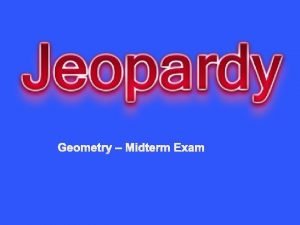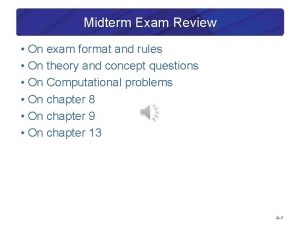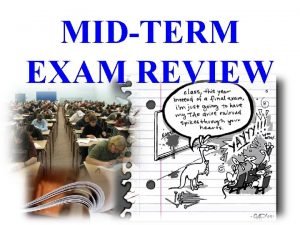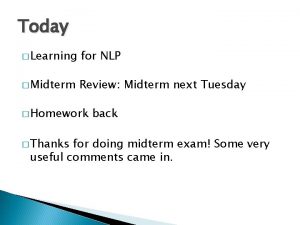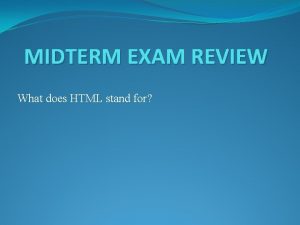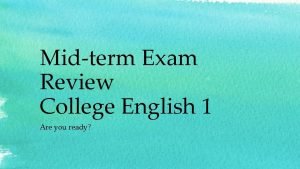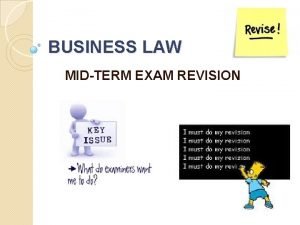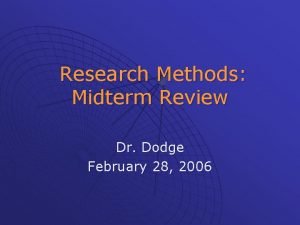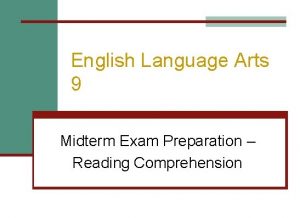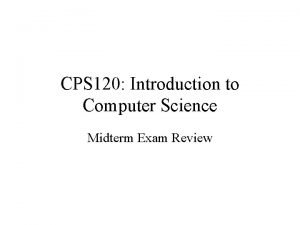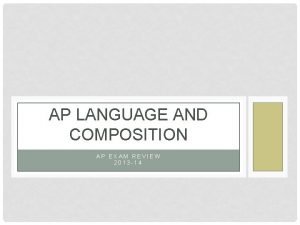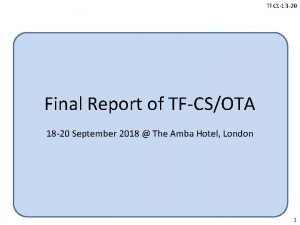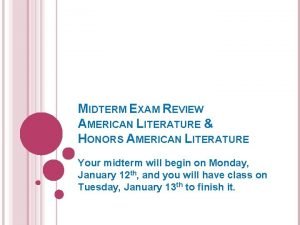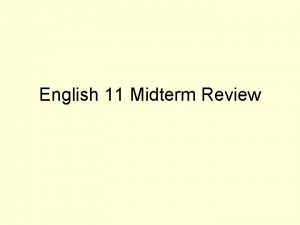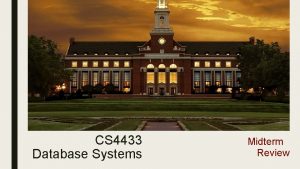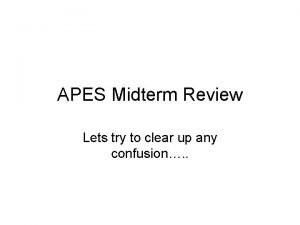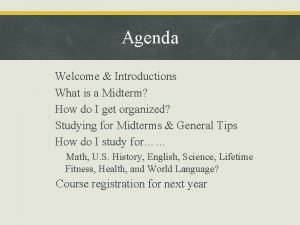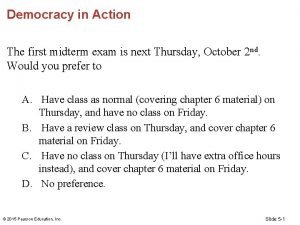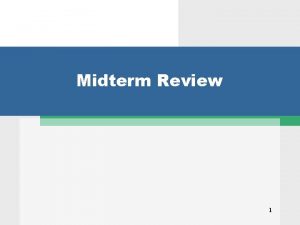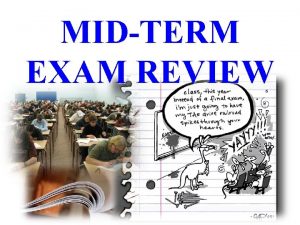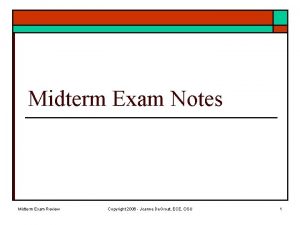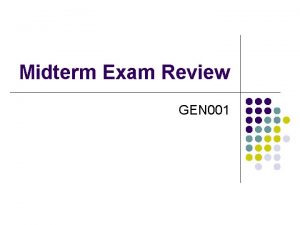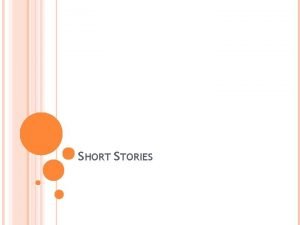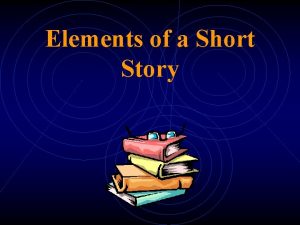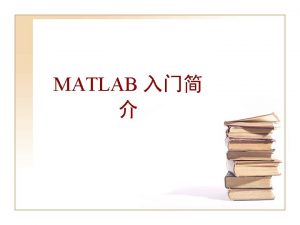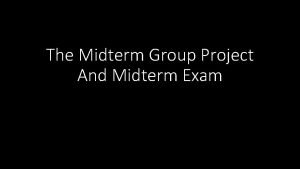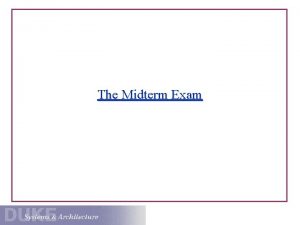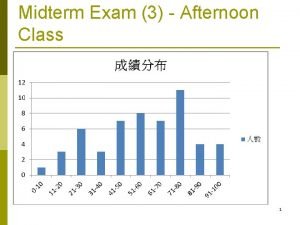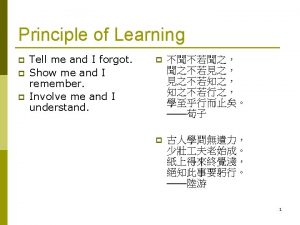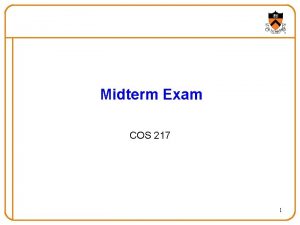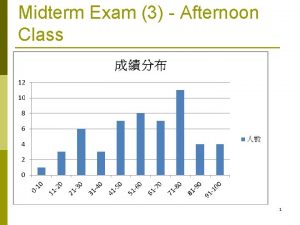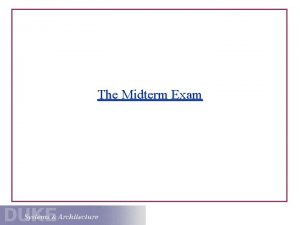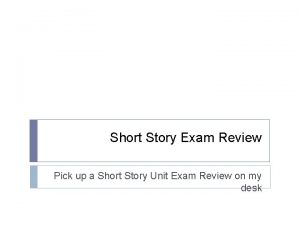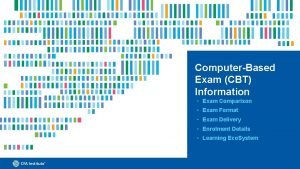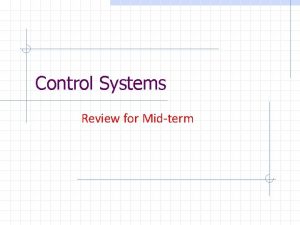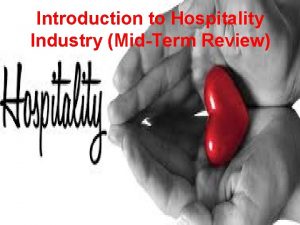MIDTERM EXAM REVIEW Format Part One Short Story























- Slides: 23

MID-TERM EXAM REVIEW

Format • Part One: Short Story and Essay Response – 40% • Part Two: Literary Terms – 10% (multiple choice pertaining to short story) • Part Three: Literature – 20% (multiple choice) • Part Four: Thematic Significance – 30% (short answer)

Part One: Short Story and Essay Response • You will read a short story by Flannery O’Connor. • IMPORTANT: Read quickly while still concentrating on understanding the story. • Be prepared to compare the short story to two other works we have studied.

• Since this is worth 40% of your exam grade, it would make sense to devote 40% of your exam time to it. • The total exam time is 90 minutes. • 40% = 36 minutes to both read and write.

Scoring Criteria • Line of Reasoning (10 Points) Do you have a perceptive thesis statement that links the works, and do the reasons and textual evidence in the essay strongly support that thesis statement? • Support (20 Points) Do you use sufficient evidence (examples) from each text to support your thesis? • Coherence (10 Points) Do you organize your thoughts coherently (logically) and use transitions effectively throughout the essay?

Flannery O’Connor …a brief overview

Praised for her literary and moral genius. • Exposes human weakness • Explores important moral questions through everyday situations.

• O’Connor utilizes biting irony to expose the blindness and ignorance of her characters. • She aims to expose the sinful nature of humanity that often goes unrecognized in the modern, secular world.

Part Two: Literary Terms • • • This section is worth 10% of your exam grade. You should take about 10 minutes on it. There are 10 multiple choice questions. The questions are about the O’Connor short story. They focus on literary terms (the elements of fiction) • These are carefully crafted questions so be careful. • You have to choose the best answer.

Elements of Fiction • Setting • Character • Plot • Point of View • Theme • Symbolism • Other

Other Fiction Elements • Allusion: a reference to a person, place or literary, historical, artistic, mythological source or event. “It was in St. Louis, Missouri, where they have that giant Mc. Donald’s thing towering over the city…”(Bean Trees 15) • Atmosphere: the prevailing emotional and mental climate of a piece of fiction. • Protagonist: The leading character in a literary work. Holden in The Catcher in the Rye, Taylor in The Bean Trees. • Antagonist: The character who opposes the protagonist. • Dialogue: the reproduction of a conversation between two of the characters.

Other Elements Continued • Foreshadowing: early clues about what will happen later in a piece of fiction. • Irony: a difference between what is expected and reality. • Style: a writer’s individual and distinct way of writing. The total of the qualities that distinguish one author’s writing from another’s. • Structure: the way time moves through a novel. • Chronological: starts at the beginning and moves through time. • Flashback: starts in the present and then goes back to the past. • Circular or Anticipatory: starts in the present, flashes back to the past, and returns to the present at the conclusion. • Panel: same story told from different viewpoints. (Lou Ann and Taylor chapters in The Bean Trees)

Part Three: Literature • This is another set of 10 multiple choice questions. • They do not pertain to the O’Connor story. • Instead, they are about the various works we have read during the semester. • They are not easy questions. Be careful. • Give yourself about 15 minutes to complete this 20 -point section of the exam.

Part Four: Thematic Significance • This section is worth 30% of the exam points. • Suggested time allotment: 20 -25 minutes • You will be given 3 quotes from the works we have read this semester. • Each one is worth 10 points. • You should have no trouble recognizing the quotes if you have read our books carefully.

What You Have to Do… • Identify the Speaker – 2 pts. • Describe the Scene – 2 pts. • State the Theme – 2 pts. • Explain Significance of Theme – 4 pts.

You Need to Know the Themes

The Bean Trees • Friendship • Choices and consequences • Human rights • Human condition

The Women of Brewster Place • Community • Female Bonding • Violence Against Women • Alienation and Loneliness • African-American Heritage • Female Sexuality

Ethan Frome • Passion • Isolation • Lost Potential • Poverty

Ordinary People • Grief and sorrow • Atonement and forgiveness • Alienation and loneliness • Identity

The Death of a Salesman • Appearance vs. Reality • Individual vs. Society • Individual vs. Self • American Dream

Outliers – 2 Theses • Highly successful people have typically benefited from some advantage of circumstance to foster their success. • One’s cultural legacy can remain a powerful force affecting one’s ability to succeed in subtle yet powerful ways.

If you “budget” your time, you should have 5 -10 minutes left to check your answers. (Be especially careful not to take too long reading the short story. ) GOOD LUCK!
 Short short short long long long short short short
Short short short long long long short short short World history semester exam
World history semester exam Bisexts
Bisexts Algebra 2 midterm exam review
Algebra 2 midterm exam review Midterm exam format
Midterm exam format Midterm for one for short
Midterm for one for short Introduction to short stories
Introduction to short stories Nlp midterm exam
Nlp midterm exam Data mining exam
Data mining exam Html midterm exam
Html midterm exam College english midterm exam
College english midterm exam Business law midterm
Business law midterm Research methods midterm
Research methods midterm English 9 midterm exam
English 9 midterm exam Introduction to computer science midterm exam
Introduction to computer science midterm exam Introduction to computer science midterm exam test
Introduction to computer science midterm exam test Ap english language and composition midterm exam
Ap english language and composition midterm exam Grva midterm exam
Grva midterm exam American literature midterm exam
American literature midterm exam English 11 midterm exam
English 11 midterm exam Database systems midterm exam
Database systems midterm exam Oligotrophic definition apes
Oligotrophic definition apes What is a midterm
What is a midterm Exam midterm
Exam midterm


